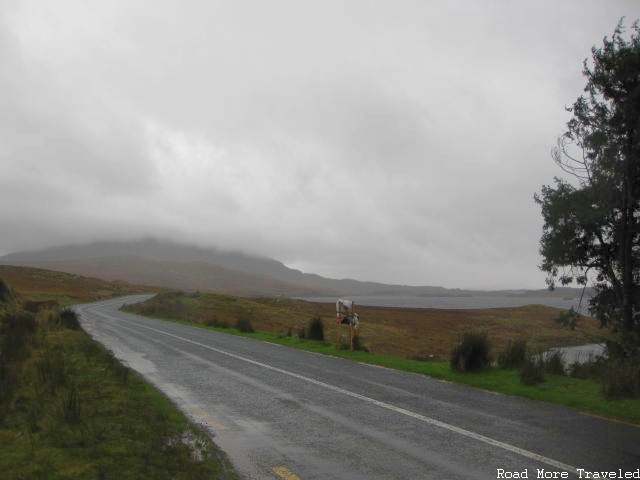
Depending on what you want to see, renting a car in Europe can add lots of fun to your trip. Most of Europe has excellent public transportation systems, especially long distance trains. However, there are still a lot of areas that are easier to reach if you have your own set of wheels, like the incredible but remote Connemara region of Ireland (pictured above). I’ve rented cars in both England and Ireland. In both cases, a car really added to the enjoyment of both trips. It allowed us to access several hard to reach areas.
If you are considering a European road trip, though, keep in mind one very important item. Per the Wall Street Journal, fines generated by photo radar traps have been proliferating, leaving American renters with unexpected bills often several months after the fact. (Note: if the link leads to a paywall, try searching for the story in Google; you can usually follow the link for free.) The reason? Governments typically forward camera tickets issued to rental cars to the rental company, who then do one of two things. They can provide your contact information to the agency, who then mails you the ticket. Or, the rental company automatically charges your credit card the cost of the tickets, plus administrative fees. Needless to say, either provides an unpleasant (and expensive) surprise, often many weeks or months later.
The concept itself isn’t entirely foreign here in the United States. After all, surprise charges and fees for accidentally venturing onto cashless toll roads have been an issue for years, especially in Florida. And many of you have probably been nabbed by red light cameras. The owner typically receives the paying paper in the mail several weeks or months after the alleged infraction. But photo radar remains controversial and relatively rare. Only a few jurisdictions permit speed cameras, with Chicago, New York City, and Washington D.C. the notable exceptions. In Europe, on the other hand, photo enforcement is nearly ubiquitious in areas. I can personally testify that practically every construction zone in England was plastered with speed cameras. In France alone, the WSJ article estimates that more than 4,000 cameras were operational by the end of 2012.
And don’t count on the mythical “fudge factor” over the speed limit allowed by police here in the U.S. In Australia, another country where photo radar has spread like weeds, the tolerance can be as low as 3 km/hr over the speed limit in the state of Victoria.
Making things more confusing, many European cities, notably London and several larger cities in Italy such as Rome and Naples, have implemented “congestion charge” or “limited traffic” schemes in an attempt to decrease traffic levels in busy city center areas. Specifically, vehicles may be charged a fixed fee to enter certain areas during certain times of day. Sometimes, they are even prohibited entirely, with substantial fines for failing to abide by the restrictions. These charges are typically enforced by closed circuit camera systems. It is, unfortunately, very, very easy to accidentally drive into a restricted zone without realizing it. Worse, even a momentary entry into a restricted zone is usually enough to trigger a fine, even if you immediately realize your mistake and turn around.
So Should I Just Forget About My Road Trip Entirely?
Predictably, a handful of the comments in the WSJ article suggest the best way to avoid camera tickets is to not drive in Europe. I’d characterize that as a gross overreaction. The best advice I can give is, simply: know before you go. As in, read up on the basic rules of the road of the countries you plan to visit. Though I’m yet to find a comprehensive website showing road rules throughout the continent, simply Googling “speed limits in [country]” will usually bring up several relevant results – such as this website which describes basic speed limit rules and road information in France. You’d at least know, for example, that France has different speed limits during rain. Such sites will often also have pictures and meanings of common road signs you will encounter.
If you’re planning to drive in Italy, it is imperative to read up on “Zona Traffico Limitato” (ZTL) areas. These aare restricted traffic zones usually found in the city centers of historic cities. This website provides a good overview of ZTLs and links to maps of some of the zones. The important things to remember: the specific boundaries and rules for ZTLs differ by city; the signs marking them and showing the rules are only in Italian; and by the time you see a sign, it may be difficult if not impossible to turn around, and entering a ZTL, even momentarily, when unauthorized will trigger a fine.
Besides that, I’d advise avoiding congested city centers, not just in Italy, but anywhere in Europe. Public transit is usually cheap and plentiful, and the headaches of navigating narrow streets, pricey, often confusing parking regulations, and congestion levels that make L.A. at rush hour on a Friday seem tame aren’t worth whatever convenience you might gain from having a car. Just enjoy your time in the city center sans car. Then when you’re ready to leave, take a taxi either back to the airport or to a suburban neighborhood location and pick up your car there.
If you’re going from one big city to another, if a one way rental isn’t economical, just park your car at the airport and take a taxi or bus/Metro from there. Airport parking is almost sure to be substantially cheaper than the valet parking at your hotel, anyway. Also, always ask the rental company how they handle photo enforcement fines, i.e. if they automatically bill fines to your credit card, or forward to you for resolution.
If you do end up with a ticket anyway, you do have some options. It may sound obvious, but review the documentation and make sure the vehicle is actually yours. If your rental company bills your card automatically, call and ask for a copy of the citation or invoice, which you have a right to see. A common issue with photo enforcement system involves transposed numbers on a license plate. The authorities then issue the citation to the wrong vehicle. If you want to try and protest a fine, beware that doing so may not be easy. Italy, for example, allows 60 days from the receipt of a photo citation to file a protest, but the protest must be filed in Italian. You might decide it’s easier just to pay up.
For the most part, though, just read up on some basic rules and follow them, and you’ll have no problems. I’ve driven in Australia, Belize, England, and Ireland without incident or any surprise tickets, and having a car has added immense enjoyment to my time in all four countries. Don’t let the fear of a speeding ticket deter your decision!




